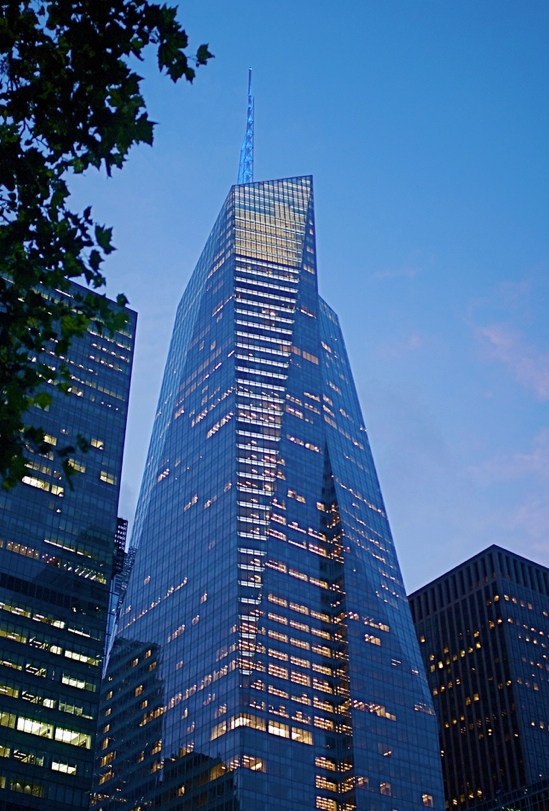
Image Credit: Allaboutskyscrapers.com
Opened in 2010, the Bank of America Tower in New York City was praised as a model of sustainability. But the LEED-Platinum building has proved to be anything but, according to an article by Sam Roudman in the New Republic.
Roudman writes that while the building boasted green features such as waterless urinals and rainwater harvesting, it actually uses twice the energy per square foot as the Empire State Building, which is 80 years old. In fact, the building produces more greenhouse gases and uses more energy per square foot than any office building of comparable size in Manhattan, Roudman says.
“LEED has helped create a market for sustainability where one didn’t exist before,” the article says. “The problem is that real-estate developers have been able to game the system, racking up points for relatively minor measures.”
Much of the energy use, however, can be traced to huge trading floors packed with computer monitors and servers.
The U.S. Green Building Council, which created and administers the LEED system, said it had no control over how the occupants use the building. “We are not the government,” Roudman quotes Scot Horst, sernior vice president for LEED as saying. “We can’t regulate anything.”
And Roudman’s assertions brought an interesting rebuttal from Treehugger writer Lloyd Alter, who thought the article amounted to “LEED-bashing.”
Weekly Newsletter
Get building science and energy efficiency advice, plus special offers, in your inbox.














5 Comments
I am absolutely not a LEED
I am absolutely not a LEED fanboi but look at what they say in Fast Company, a usually reputable website:
LEED neglects how buildings are used and instead focuses on issues of architectural and engineering design, much of which can be qualified as “cosmetic.” In some cases, developers are able amass points for trivial concessions, such as parking spots for hybrid cars and bike racks; in others, simply being located in a densely populated area, like Manhattan, will earn you cheap LEED love. The USGBC is chaired by architects, builders, and suppliers, all of whom stand to profit from the huge and rapidly growing sustainable building market the certification helped create.
I happen to believe that there are points for building in densely populated areas, in building bike racks and storage and changerooms, this stuff is not trivial. Thanks for at least mentioning me.
Just being objective...
Even if one cuts some of the "cheap LEED love" out, does it knock it down to a LEED-Gold? We're still talking about a legit building.
Maybe the article is really trying to point out the disparity between projection-based programs and review-style programs (i.e., modeling or LEED vs. real usage or LBC).
And last I checked, LEED isn't just about energy. Other facets of the building are important to the overall sustainability goal.
this has turned into a free for all,
Roudman wrote a reply to my post in Metropolis http://www.metropolismag.com/Point-of-View/August-2013/The-Debate-on-the-Bank-of-America-Tower-Continues/ and I responded to him http://www.treehugger.com/urban-design/debate-bank-america-tower-continues-round-4.html
Fundamentally it comes down to a weird LEED certification called "Core and Shell" where developers get to ignore the use that comes after they build the building. But the original article is still way off base.
Energy storage not counted as savings
I have long been critical of all-glass buildings, from an energy standpoint. It's very hard to create such buildings and not have them be energy hogs. Data-heavy uses exacerbate the situation. So I won't go too far in defending this building.
But, a key feature of the Bank of America building is its thermal energy storage (TES) system in which off-peak electricity is used at night to make ice, and that ice is used during the daytime to provide a significant portion of the cooling for the building. In New York City, baseload power plants are less polluting than peaking plants that have to get fired up to meet daytime peak loads. More BTUs are consumed in the TES system, but they are cleaner and less expensive BTUs. The City's energy reporting, as I understand it, doesn't provide any bonus for that off-peak electricity use.
Energy Hog?
This is a very unfair article. It should be pointed out that the New Republic is a conservative-leaning publication and has an agenda - bashing LEED and everything that even smells of sustainability. If you took the time to click on the last link and read the article at Tree Hugger, you'd get the full picture. Shame on the author! I'm not a fan of LEED, by the way, but I am a big fan of objectivity and fairness, which this article is not.
Log in or create an account to post a comment.
Sign up Log in